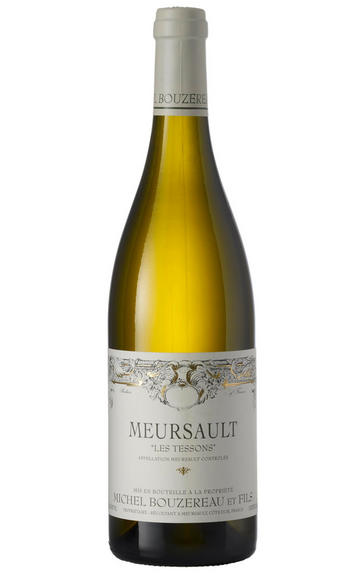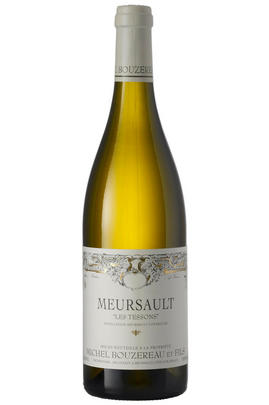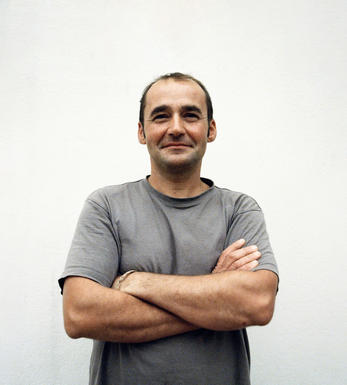
2018 Meursault, Les Tessons, Michel Bouzereau & Fils, Burgundy

Critics reviews
Fresh, bright colour, with a little lime streak. The nose has more weight of fruit than the Grands Charrons. Subtle, quite elegant, then with rather more flesh on the palate. Spring flowers are quite understated. It has charm in the attack but with good balance, thinks Jean-Baptiste.
Jasper Morris MW, InsideBurgundy.com (November 2019)
There is a touch of matchstick character to the airy and cool floral, apple, roasted nut and citrus aromas that introduce intense, well-detailed, and slightly more concentrated flavours that exude a subtle minerality on the clean, dry, focused finale. This needs to develop more depth, but it is a wine that should be drunk well after only a few years of age but repaid at least 8 to 10.
Drink from 2026 onward
Allen Meadows, Burghound.com (June 2020)
Bottled in February 2020, the 2018 Meursault Les Tessons has a nicely detailed walnut bouquet and light smoky aromas unfold in the glass. The palate is very well balanced with a fine bead of acidity, nice poise and a touch of dried honey and lemon curd toward the finish. Apricot lingers on the aftertaste. Very easy to drink now, yet it has the legs to give 15 years of drinking pleasure.
Drink 2022 - 2034
Neal Martin, Vinous.com (December 2020)
About this WINE

Domaine Michel Bouzereau
The Bouzereau clan is widespread in the village of Meursault, with Domaine Michel Bouzereau at the forefront. Michel Bouzereau comes from a large winemaking family and has held the post of President of the Burgundy Growers Union. His is a voice to be heard. And what he likes to talk about is the traditional way of making wine. He ferments in cask and gives his wines nine months on their lees. Determined that his wines will smell and taste only of wine, the importance of new wood is acknowledged but downplayed. Michel's son Jean Baptiste is now in charge of making the seventeen wines from this 11 hectare estate.
Jean-Baptiste has respected his father's more traditionalist practices but he has instilled a fresher, livelier element to the wines which only enhances their appeal. These wines offer very good value for money and are benchmark examples for each of the crus. They can also age better than could be expected. The whites of this domaine are those most likely to be singled out, with perhaps the Premier Cru of Les Genevrières being the finest.
Their Bourgogne Blanc comes from vineyards which are within the boundaries of Meursault but just outside the appellation. Such generic Burgundies are excellent choices for good value, especially as this wine is treated with the same care, attention and barrel ageing as its more senior brethren.

Meursault
There are more top producers in Meursault than in any other commune of the Côte d’Or. Certainly it is the most famous and popular of the great white appellations. Its wines are typically rich and savoury with nutty, honeyed hints and buttery, vanilla spice from the oak.
Even though it is considerably larger than its southerly neighbours Chassagne and Puligny, Meursault contains no Grands Crus. Its three best Premiers Crus, however – Les Perrières, Les Genevrières and Les Charmes – produce some of the region’s greatest whites: they are full, round and powerful, and age very well. Les Perrières in particular can produce wines of Grand Cru quality, a fact that is often reflected in its price. Meursault has also been one of the driving forces of biodynamic viticulture in the region, as pioneered by Lafon and Leflaive.Many of the vineyards below Premier Cru, known as ‘village’ wines, are also well worth looking at. The growers vinify their different vineyard holdings separately, which rarely happens in Puligny or Chassagne. Such wines can be labelled with the ‘lieu-dit’ vineyard alongside (although in smaller type to) the Meursault name.
Premier Cru Meursault should be enjoyed from five to 15 years of age, although top examples can last even longer. Village wines, meanwhile, are normally at their best from three to 10 years.
Very occasionally, red Meursault is produced with some fine, firm results. The best red Pinot Noir terroir, Les Santenots, is afforded the courtesy title of Volnay Santenots, even though it is actually in Meursault.
- 305 hectares of village Meursault. The best vineyards include Clos de la Barre, Tesson, Chevalières, Rougeot, Narvaux
- 132 hectares of Premier Cru vineyards (17 in all). The finest vineyards include Les Perrières, Les Genevrières and Les Charmes
- Recommended producers: Comte Lafon, Arnaud Ente, Coche Dury, Guy Roulot, Jean-Philippe Fichet, Patrick Javillier, François Jobard, Michel Bouzereau
- Recommended restaurant: Le Chevreuil

Chardonnay
Chardonnay is often seen as the king of white wine grapes and one of the most widely planted in the world It is suited to a wide variety of soils, though it excels in soils with a high limestone content as found in Champagne, Chablis, and the Côte D`Or.
Burgundy is Chardonnay's spiritual home and the best White Burgundies are dry, rich, honeyed wines with marvellous poise, elegance and balance. They are unquestionably the finest dry white wines in the world. Chardonnay plays a crucial role in the Champagne blend, providing structure and finesse, and is the sole grape in Blanc de Blancs.
It is quantitatively important in California and Australia, is widely planted in Chile and South Africa, and is the second most widely planted grape in New Zealand. In warm climates Chardonnay has a tendency to develop very high sugar levels during the final stages of ripening and this can occur at the expense of acidity. Late picking is a common problem and can result in blowsy and flabby wines that lack structure and definition.
Recently in the New World, we have seen a move towards more elegant, better- balanced and less oak-driven Chardonnays, and this is to be welcomed.


Buying options
Add to wishlist
Description
This small four-hectare vineyard is above Les Grands Charrons, with more limestone. The domaine’s vines are over 50 years old, producing a wine that is tight and vibrant, with lovely tension, as well as cooler notes of acacia and blossom. The more spartan terroir is beautifully evident.
Drink 2022 - 2028
wine at a glance
Delivery and quality guarantee